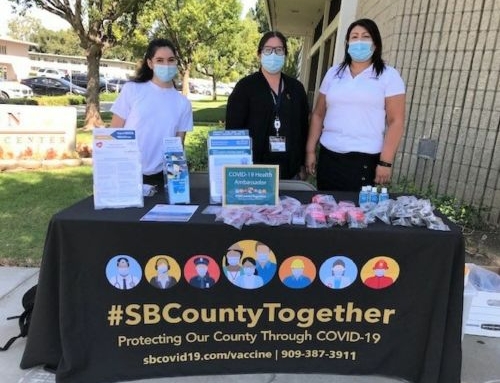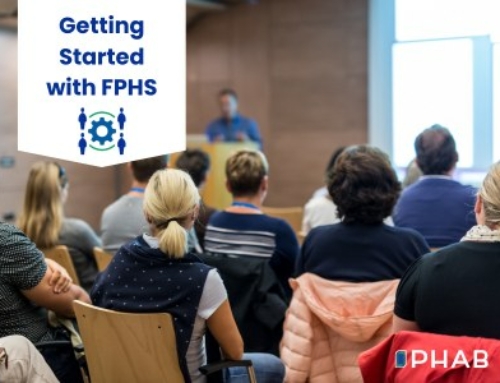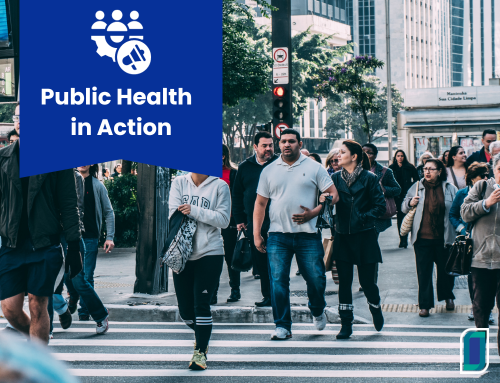PHAB’s Center for Innovation and the Center for Sharing Public Health Services (CPHS) recently announced grant awards totaling nearly $1.5 million have been made to 10 grantees to support collaborations between governmental public health, healthcare, and social services. Provided as part of the Cross-sector Innovation Initiative (CSII) and with funding from the Robert Wood Johnson Foundation, the grants will advance the efforts of grantees to implement innovative multi-sector partnerships between governmental public health, healthcare, and social service organizations, along with the engagement of their communities, with the ultimate goal of aligning the three sectors’ work to improve population health, well-being, and equity for all. The 10 grant recipients and summaries of their projects are below – keep an eye out for future blog features as the grantees progress over the next two years.
Better Health Together (WA)
A Collaborative Approach to Community Equity in Spokane County, WA
In 2020, the Spokane Collaborative will begin to address three equity priorities in Eastern Washington: reducing family violence & trauma, increasing access to affordable housing, and access to behavioral health treatment. During the course of the grant, Better Health Together (BHT) and the Spokane Regional Health District (SRHD) Data Center will develop an evaluation plan for the Collaborative’s equity projects and priorities, as well as evaluation of collaboration and interactions between partners. Through workshopping and partnership-building activities, Collaborative members will collectively develop equity workplans and commit to activities, staffing, ongoing partnership-building, and supporting evaluations.
Cabarrus County Partnership For Children (NC)
Substance Use Network (SUN) Project – A Collaborative System of Care for Pregnant Mothers with Substance Use Disorder, Their Infants, and Families
The SUN Project will develop a sustainable, cross-sector, collaborative system of care that uses best practices to support the health, safety, well-being and recovery of pregnant mothers with substance use disorder (SUD), their infants and families. Due to fear, stigma and systemic barriers to care, pregnant women with SUD experience health inequities that impact both mother and child. These health inequities have become a focus for public health and other service providers in our community. Pregnancy presents an opportune time for collaborative, comprehensive intervention due to an increased motivator for behavior change and the ability to begin services even before the child is born. SUN operates using SAMHSA’s framework entitled, “A Collaborative Approach to the Treatment of Pregnant Women with Opioid Use Disorders (2016)” to guide provider collaboration. SUN’s innovative approach focusing on mothers with SUD postulates that the subgroup of substance users who experiences the most stigma and health disparities may very well be the key to making the most impact on the overall opioid epidemic.
Case Western Reserve University (OH)
The Health Improvement Partnership: Cuyahoga’s Quest to Achieve Equity – Applying Community-based System Dynamics to Tackle Structural Racisms in Greater Cleveland
This project will employ participatory group model building (GMB) using community-based system dynamics (CBSD) to create a detailed understanding of structural racism impacts in Cuyahoga County. The resulting system dynamics models will identify actionable and transportable strategies and lever points for advancing equity. Five group model building sessions grounded in equity and CBSD with cross-sector community partners will be co-led by a sector representative and a community resident. Each sector lead will recruit diverse stakeholder engagement for GMB sessions. CBSD that engage communities and multisector collaborations through participatory modeling enable participants to see and formulate interventions and strategies to address systemic issues, such as structural racism. Participants will create maps of structural racism impact across multiple sector perspectives to identify lever points for action on short, intermediate and long-term timeframes. Subsequently, a community summit will engage all participants to identify pragmatic opportunities for short, intermediate and long-term action, and a concrete timeline to fund and operationalize multi-level initiatives to eliminate structural racism.
Chatham County Public Health Department (NC)
Equity for Moms and Babies Realized Across Chatham (EMBRACe)
EMBRACe seeks to ensure successful and equitable birth outcomes for women and babies in Chatham County, NC, through system and service alignment across the following partners: Chatham County Public Health Department, Chatham Hospital, UNC Family Medicine, Piedmont Health Services, Chatham County Department of Social Services and the Chatham Health Alliance. The proposed project is an outcomes-focused initiative launched out of ongoing efforts in the county to work collaboratively across sectors to address the root causes of the county’s most pressing health disparities. In pursuit of system alignment, we will establish a formal structure of collaborative governance, engage community members from the populations we serve, build systems for data sharing that facilitate data-driven decision-making and seamless service alignment, and cultivate innovative revenue and funding opportunities. We will align our services to ensure that all women who receive prenatal, intrapartum and postpartum services from project partners are treated with dignity and respect, establish an evidence-based continuum of services, and lead data and community-informed systems-level initiatives to address psychosocial barriers to positive birth outcomes.
Health Education Council, Serving Populations at Risk (CA)
West Sacramento Accountable Community for Health (WSAC-ACH): Working Together to Promote Healthy Lives & Happy Hearts – A Multi-sector Alliance of Health, Local Government, and Community Partners Dedicated to Health Equity Focused on Access to Healthy Food, Improved Walkability, Community Connection, and Tobacco Prevention
WSAC-ACH is a multi-sector alliance of health, local government, social services and residents working to promote healthy, happy hearts: aiming to reduce cardiovascular disease risk and morbidity especially in highly impacted neighborhoods. WSAC-ACH will align resources across sectors, focusing on data sharing, sustainability and interventions to improve strategies and outcomes responsive to resident heart health-priorities. The WSAC-ACH has prioritized equity and community engagement as core principles and is actively engaging diverse residents. WSAC-ACH uses community-based asset mapping and participatory approaches to activate community assets, build resident advocacy and increase social connection among residents to impact the resident-priorities of healthy food access, walkability, social connectedness and tobacco prevention. Self-sufficiency is key goal of WSAC-ACH and has been woven into its design. The collaborative will design a long-term funding mechanism like a Community Wellness Investment Fund, which will align new funding and redirect existing funding to heart disease prevention in West Sacramento’s low-income neighborhoods.
Hennepin County Public Health Department (MN)
Community Health Improvement Partnership (CHIP) of Hennepin County: Advancing Community Mental Well-Being and Housing Stability through Community Partnership
Community mental well-being and housing stability are priorities in communities of color and indigenous populations in Hennepin County. These communities know that great disparities exist for their communities and have ideas and solutions. What is missing is funding and political will by the systems that created these disparities. CHIP of Hennepin County, a coalition of partners including public, private and nonprofit sectors with key representation from public health, healthcare/health plans, subject matter experts in mental health and housing, education, and others, focuses on partnership with and support for these communities to address historical trauma created and exacerbated by our policies and practices; create social connectedness in rental communities; and equitable screening criteria to help vulnerable populations get housed. Alignment will be driven by community expertise and developmental evaluation. CHIP partners will use collaborative financing and financial accountability to ensure communities are supported. Population goals focus on funding communities for their expertise, while CHIP partner organizations develop and adopt trauma-responsive policies and practices. Housing stability will increase through social connectedness and equitable tenant screening. Health and racial equity were prioritized by the community and are at the core of our work. CHIP built community feedback conversations into its plan to ensure the voice of the community is heard as CHIP adjusts or alters its strategies to include this feedback.
Ledge Light Health District (CT)
The Health Improvement Collaborative (HIC) of Southeastern Connecticut – Engaging Community to Pursue a Healthy and Equitable Future by Addressing Structural Racism
The HIC will advance systems alignment work in both a formal structured way – by developing by-laws, financing structures, membership agreements, etc., and in a project-based experiential way – by advancing its collective work on racism as a public health issue. We will expand community engagement so that community voice is centered at every level of the collaborative. While participating HIC organizations provide services to community members, too often service or care delivery is designed without incorporating the voices of people with lived experience and without considering a racial equity lens. The HIC’s established values include the intentional creation of a culture of trust, authenticity in seeking community involvement, inclusiveness, respectfulness of cultural consideration and differences, and social justice. Our systems alignment work will institutionalize those values in our governance and financing structures. The HIC also will advance its efforts to understand racism as a public health issue and create meaningful change as organizations examine their policies and practices through a racial equity lens.
Minneapolis Health Department (MN)
Minneapolis Highrise Health Alliance: Leadership and Action for Healthier Minneapolis Public Health Authority Residents
Since 2014, the Minneapolis Health Department, Minneapolis Public Housing Authority, Minneapolis Highrise Representatives Council and Volunteers of America have collaborated to increase health amenities and integrate community health workers (CHWs) into public housing highrise buildings. To increase impact and sustainability, this partnership has begun healthcare sector partner engagement and is poised to initiate a sector alignment effort. The partnership will formalize into the Minneapolis Highrise Health Alliance (Alliance) that will work toward sector alignment to improve physical and mental healthcare coordination and health outcomes for highrise residents. In the first year, the Alliance will establish a formal structure including a leadership committee and workgroups. Through this structure Alliance members will gather and use data on highrise residents’ health to set priorities and identify strategies to achieve alignment that leverage the CHWs as an onsite resource. The Alliance will choose at least two short-term alignment strategies to fund, implement and evaluate in year two. Residents will be continuously engaged and their voices will drive the work. By the end of year two, the Alliance will have tested some alignment strategies and developed an effective structure to sustain the work.
Mountain Area Health Education Center (NC)
Mothering Asheville – A Community-centered Health Movement to Address Institutional Racism, Implicit Bias, Access to Care, and Social Determinants of Health as Root Causes of Birth Inequities
Partners connected to Mothering Asheville and Buncombe County’s Community Health Improvement Process (CHIP) seek to increase and align cross-sector collaboration to reduce racial inequities in birth outcomes and infant mortality by 2027. While CHIP and Mothering Asheville have collaborative bodies working to address this issue, additional funding to align and increase cross-sector collaboration would increase the effectiveness of the program and increase the likelihood of significantly reducing racial disparities. This project seeks to do that by inviting potential community partners who are separately working to decrease racial inequities to be part of our movement, authentically engaging communities most impacted by these inequities in reviewing and co-designing upstream and downstream solutions, increasing awareness in the general community regarding the scope of the problem and root causes through community engagement and data visualization, and by developing short- and long-term funding strategies to significantly change the systems that create these inequities.
Napa County Health and Human Services Agency, Public Health Division (CA)
Aligned Through Design: Improving Health Equity in Napa County through Shared Data and Human-centered Strategies
Live Healthy Napa County (LHNC) is a multi-sector collaborative that first convened in 2012 to develop a shared vision and plan to make sustainable improvements in the health of all people who live and work in Napa County. Public Health, Community Health Initiative and Cope Family Center, three long-time partners, have a shared priority of addressing health inequities through increasing respect and social inclusion. Social inclusion is an important determinant of health, with isolation and stigma contributing to poor health outcomes. Moreover, it is an accessible, non-threatening topic for engagement with our community members which often opens the door to discussion of a range of health-related topics. As we seek to improve health equity, LHNC is focused on lifting up the voices and lived experience of underserved communities. Our project will expand the use of human-centered design as a tool for engaging community in the planning and implementation of solutions to identified health-related challenges, starting with a focus on respect and social inclusion. Our organizations, all part of the public health system in Napa County, seek to improve systems alignment though shared outcomes, data and measurement that focuses specifically on the qualitative data captured through the use of human-centered design.





